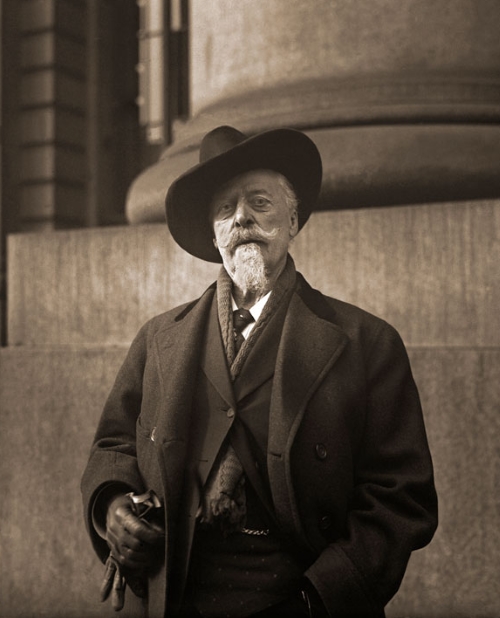Summary | Excerpt | Reviews | Beyond the Book | Read-Alikes | Genres & Themes | Author Bio

This article relates to Canoes
 In Maylis de Kerangal's new short story collection, Canoes, a woman moves from Paris to Golden, Colorado, a mining town in the foothills of the Rockies. At the top of Lookout Mountain, overlooking Golden, Buffalo Bill is buried—which surprises the woman, who thought Buffalo Bill was a fictional character.
In Maylis de Kerangal's new short story collection, Canoes, a woman moves from Paris to Golden, Colorado, a mining town in the foothills of the Rockies. At the top of Lookout Mountain, overlooking Golden, Buffalo Bill is buried—which surprises the woman, who thought Buffalo Bill was a fictional character.
Who was Buffalo Bill? It's difficult to separate the real man from the legend, especially because he most likely fabricated so many stories about himself; according to True West Magazine, he "managed to make a career out of walking the line between truth and fiction, real frontiersman and glam showman." He was born William F. Cody in 1846, and grew up on his family's farm in Kansas. His father died when he was eleven, partly due to injuries he sustained while giving an antislavery speech. After this, Cody started working for a freight company, delivering messages on horseback. Later, he would claim to have worked for the Pony Express, going on adventurous rides hundreds of miles long to deliver messages, which historians doubt is true. He did work as an Army scout, and he got his nickname because he was a market hunter—killing buffalo—supplying meat to workers on the Kansas Pacific Railroad. As frontiersmen went, for the most part, he was pretty ordinary. He was certainly a skilled horseman, hunter, and fighter, but more importantly, he was a talented storyteller.
In 1868, Cody began working under Philip Sheridan, the commanding general of the army, whose tactic for defeating Natives was to exterminate the buffalo, eliminating tribes' food source such that they would have to concede to live on reservations. Cody set out to kill as many buffalo as he could. Journalists traveled with the group to document the hunts, and Cody saw his first real opportunity for fame—by telling exaggerated stories of his exploits. He partnered with authors of dime-store novels and started commissioning plays about his adventures; soon, he was regularly traveling back and forth between the West, where he was killing buffalo, and East, where he was starring in stage shows about his (fictionalized or dramatized) adventures in the West.
Later, wanting to fight "Indians" for real, he joined the army in order to fight in the Plains Wars, which gave him more fodder for the stage. In 1883, he debuted his famous show, Buffalo Bill's Wild West and Congress of Rough Riders of the World. In an essay for Time magazine adapted from her book Mediocre, Ijeoma Oluo writes that the Wild West show "offered everything that white men in search of power and glory were looking for," a narrative in which "white men were noble and brave" and "fearlessly tamed animals and fought savages." It became the most popular show in the country, and Cody gained international wealth and fame. He also marketed the show as educational, not just entertainment, which led to "the racist, exaggerated stories of white male American bravery, leadership, and righteous victory [becoming] a part of our collective understanding of American history."
The Wild West show featured Native performers in "Indian" roles. While racist and exploitative, this also, according to an article by Mariah Wahl, "made space for the cultural expression of many of his performers, and the opportunity to be viewed as skilled horsemen and warriors, rather than as the undomesticated portrayal sought after by an increasingly industrialized world." Cody eventually changed the show to be less about "his own feats in overcoming Indian warriors" and more "a celebration of their accomplishments and culture (albeit, within a white-washed and stereotypical context)." As Cody worked with Native people on his show, he apparently became less comfortable with portrayal of his most famous exploit—the scalping of a Cheyenne war chief named Yellow Hand—and removed it from production. By the end of his life, he was speaking out against scalping and expressing regret over the buffalo massacre that had given him his name.
Glass-plate image of Buffalo Bill a.k.a. William F. Cody, taken before his death in 1917
Via Chicago Tribune Archives with retouching
Filed under People, Eras & Events
![]() This article relates to Canoes.
It first ran in the November 6, 2024
issue of BookBrowse Recommends.
This article relates to Canoes.
It first ran in the November 6, 2024
issue of BookBrowse Recommends.
Judge a man by his questions rather than by his answers.
Click Here to find out who said this, as well as discovering other famous literary quotes!
Your guide toexceptional books
BookBrowse seeks out and recommends the best in contemporary fiction and nonfiction—books that not only engage and entertain but also deepen our understanding of ourselves and the world around us.